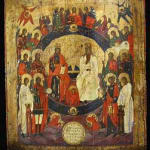Kingdom in Heaven, 18th Century CE - 19th Century CE
Tempera On Wood
20.5
PF.5755
Further images
Inseparable from the liturgical tradition, religious art is seen by Orthodox Christians as a form of pictorial confession of faith and a channel of religious experience. Because the icons provide...
Inseparable from the liturgical tradition, religious art is seen by Orthodox Christians as a form of pictorial confession of faith and a channel of religious experience. Because the icons provide direct personal contact with the holy persons represented on them, these images were objects of veneration, in either a public or private setting or during travels, and were even believed to have the ability to heal.
Christ and God, both crowned and enthroned, share equal prominence in this composition. The Holy Ghost, symbolized by a white dove, can be seen in between the two, slightly above the level of their heads, emitting a radiant luminosity. A thick blue ring encloses these holy figures and offsets them from the mass of saints and angels that flank either side. This scene takes place in heaven, symbolically represented by the elegant gold leaf background. Although this background is commonplace is Orthodox iconography, we can be sure that we are actually in heaven due to the representation of the ground. Instead of a terrestrial setting, this scene depicts a celestial setting, and the angels stand on a sea of purple clouds. We are to understand not that this is a divine event occurring on earth, but that we are in the realm of the divine. This is heaven. The four gospel writers are present in their symbolic forms: St. Mark the lion and St. Luke the bull both rising out of the layer of clouds in the center and St. Mathew the angel and St. John the eagle both hovering next to three angels above the blue circle. This composition is simply stunning; as well it should be representing such a significant scene. This icon transports the viewer directly into God’s kingdom in heaven. His son, Christ, is our link to this realm. Through him, we can achieve eternal salvation and join the ranks of the holy, thereby entering this scene ourselves.
Christ and God, both crowned and enthroned, share equal prominence in this composition. The Holy Ghost, symbolized by a white dove, can be seen in between the two, slightly above the level of their heads, emitting a radiant luminosity. A thick blue ring encloses these holy figures and offsets them from the mass of saints and angels that flank either side. This scene takes place in heaven, symbolically represented by the elegant gold leaf background. Although this background is commonplace is Orthodox iconography, we can be sure that we are actually in heaven due to the representation of the ground. Instead of a terrestrial setting, this scene depicts a celestial setting, and the angels stand on a sea of purple clouds. We are to understand not that this is a divine event occurring on earth, but that we are in the realm of the divine. This is heaven. The four gospel writers are present in their symbolic forms: St. Mark the lion and St. Luke the bull both rising out of the layer of clouds in the center and St. Mathew the angel and St. John the eagle both hovering next to three angels above the blue circle. This composition is simply stunning; as well it should be representing such a significant scene. This icon transports the viewer directly into God’s kingdom in heaven. His son, Christ, is our link to this realm. Through him, we can achieve eternal salvation and join the ranks of the holy, thereby entering this scene ourselves.







